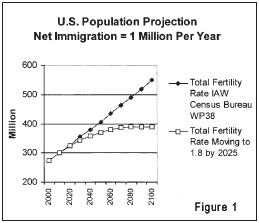AND THE CROWD GROWS WILD!
Solutions to the Problem of US Population Growth
We recently ran across a theory explaining that the world's population used to be very small because way back then, when the world was flat, enough people kept falling off the edge to keep the population stable. However, the Flat Earth Society recently distanced itself from this theory, noting that people living near the edges used to wear elastic safety tethers and could not have simply fallen off.
 Well, myths about the world's first bungee jumpers aside, global population today is anything but small, and it's still growing. US population is also growing, and that's not a good thing.
Well, myths about the world's first bungee jumpers aside, global population today is anything but small, and it's still growing. US population is also growing, and that's not a good thing.
In the last Eco-Logical, we discussed the relationship between population growth, sprawl, and traffic congestion. Today's Eco-Logical offers part 2 of a two-part series by Edwin Stennett, author of the book In Growth We Trust: Sprawl, Smart Growth, and Rapid Population Growth.
~ ~ ~
Rekindling the National Discourse on US Population Growth, pt 2 by Edwin Stennett
The growth mantra
We hear the phrase repeated endlessly: Growth is Good. Growth brings jobs, growth brings prosperity, growth prevents economic stagnation... But as the Rockefeller Commission found back in 1972, there is no hard data to back up this sentiment. Job growth has no significant impact on unemployment, and growth in personal income is not related to population growth.
"The health of our country does not depend on population growth, nor does the vitality of business, nor the welfare of the average person."
— Rockefeller Commission 1972 Report
The Growth Machine (i.e. cities' chambers of commerce, boards of trade, etc.) always touts its efforts to recruit corporations and jobs into an area. Yet relatively few local residents ever see any lasting benefits. According to Timothy Bartik, an economist with the Upjohn Institute for Employment Research, "In the long run, if you
 create five jobs, four of them go to people who otherwise would be living someplace else." Even in the short term, nearly half of these new jobs are filled by people who move into the area from other cities.
create five jobs, four of them go to people who otherwise would be living someplace else." Even in the short term, nearly half of these new jobs are filled by people who move into the area from other cities.
These new workers bring their cars, which need more roads, and their children, who need more teachers, and their housing needs, which leads to more development and the further urbanization of the area. The net result is that unemployment rates remain essentially unaffected, while congestion rises and the quality of living continues to plummet.
Solutions
The problem of US population growth deeply affects us all, but many people avoid the population issue because they assume that US population cannot be stabilized without advocating a reduction in immigration levels, or they assume that stabilization means intruding on individual choice and forcing families to only have one or two children. Both assumptions are false—there are socially acceptable solutions to the problem.
Current net US immigration is about 1 million per year and the total fertility rate is 2.05 children per woman. If we could establish and maintain a fertility rate of 1.8 children per woman, we would soon stabilize our population—even with a net immigration of 1 million per year. For a wealthy nation, 1.8 is still a high fertility rate—Canada is at 1.6 and Germany 1.3.
This surprising good news is illustrated in Figure 1. Both curves in the graph project US population growth assuming
 a constant net immigration of 1 million per year throughout the century. The key to the dramatic difference in the two curves is that the upper curve reflects the Census Bureau projection that US fertility will climb quickly from 2.05 to more than 2.2 children per woman.
a constant net immigration of 1 million per year throughout the century. The key to the dramatic difference in the two curves is that the upper curve reflects the Census Bureau projection that US fertility will climb quickly from 2.05 to more than 2.2 children per woman.
The Census Bureau tacitly assumes that there will be no effort to educate and influence fertility in a more beneficial direction. However, there are a number of steps that can be taken that would not only influence fertility rate, but also provide other important societal benefits.
Some of the steps towards decreasing the fertility rate include:
- reducing the high school dropout rate,
- reducing poverty,
- providing quality family planning services to women living in or near poverty, and
- using the immense potential of the media to educate all Americans in regard to child bearing.
Inscribed on a granite wall at the Franklin D. Roosevelt memorial in Washington is the quote:
"The test of our progress is not whether we add more to the abundance of those who have much; it is whether we provide enough for those who have too little."
Aiding those who have too little is not simply an act of altruism. It is an act that will benefit our children and grandchildren in a very tangible way. Conversely, failing to aid those who have too little will cause our children and grandchildren to suffer increasing quality of life declines—driven by continuing rapid population growth.
End Part 2 of 2
| Edwin Stennett is author of In Growth We Trust: Sprawl, Smart Growth, and Rapid Population Growth, a book that strives to clearly and forcefully draw out the links between overpopulation and local, community-level problems. For more information about the book or to purchase it, visit this Amazon.com page. |
|
~ ~ ~
We know that the steps needed for the US to achieve a lower level of population will be slightly more difficult than the steps it took the Grinning Planet team to achieve the low level of buckaroos in the company bank account, but it's clear that it can be done. And given the growing threat to our quality of life, now seems like a good time to start.
Resources:
Other parts in this series: 1 | 2
Get Grinning Planet free via email
|


